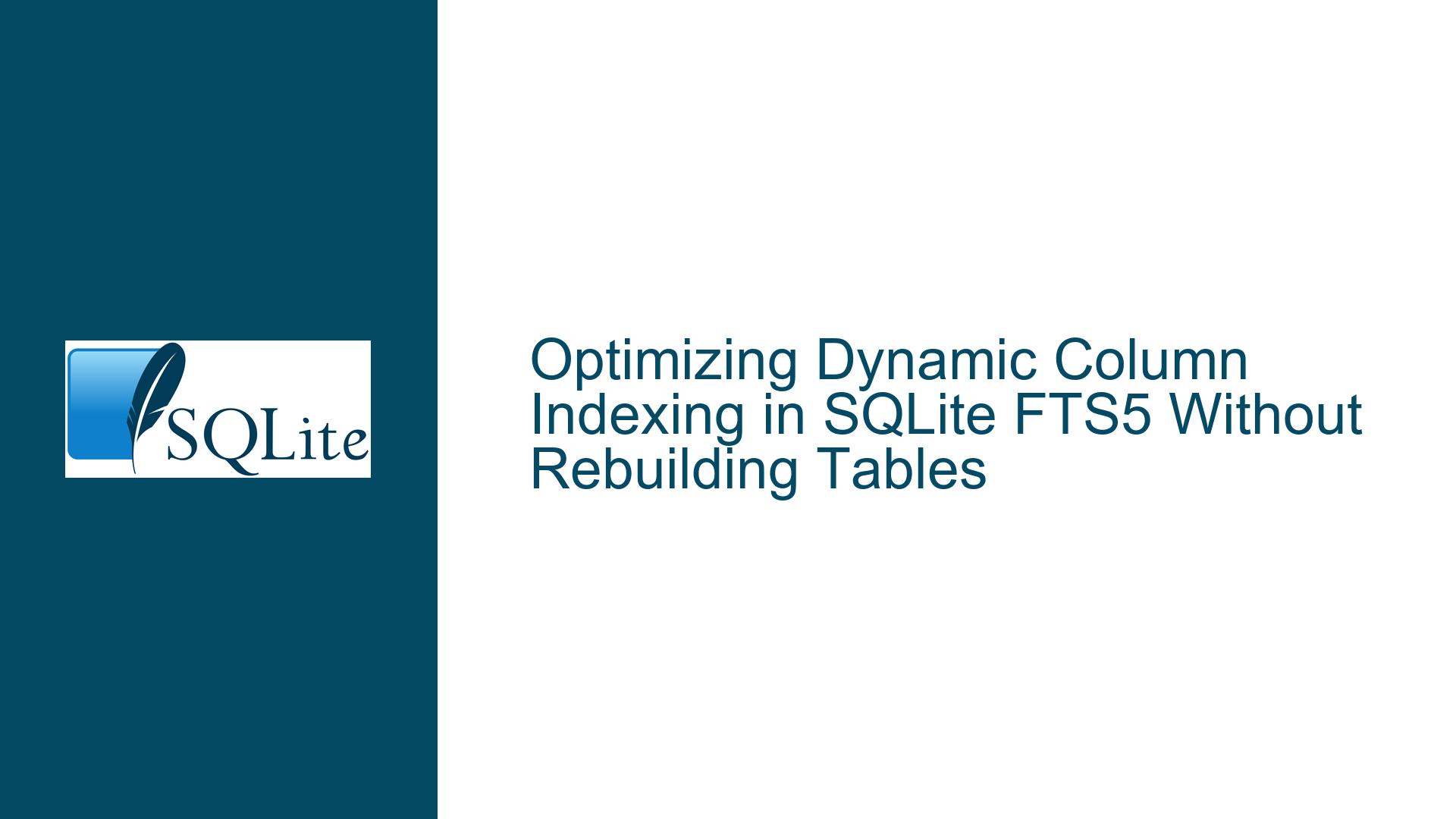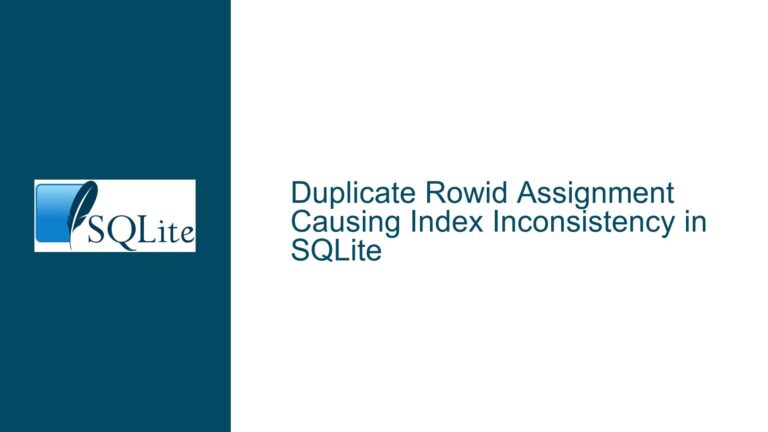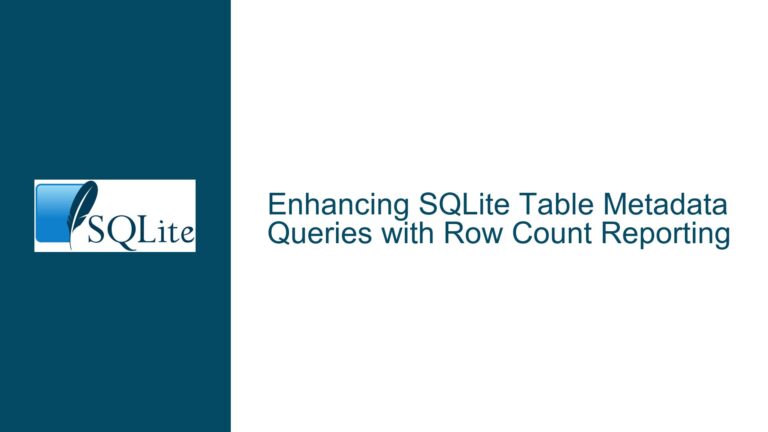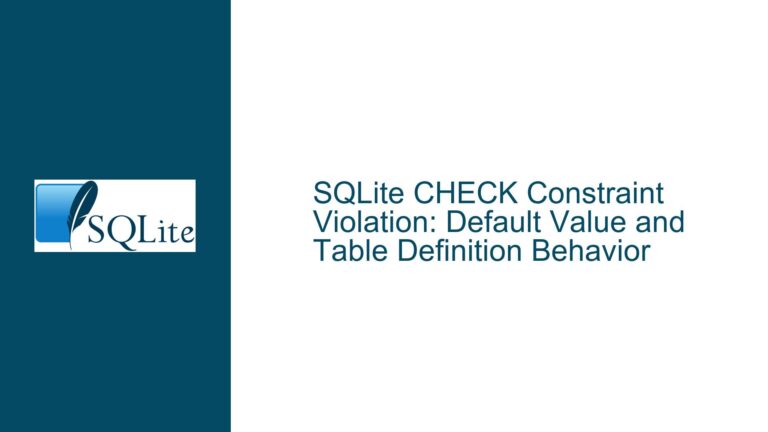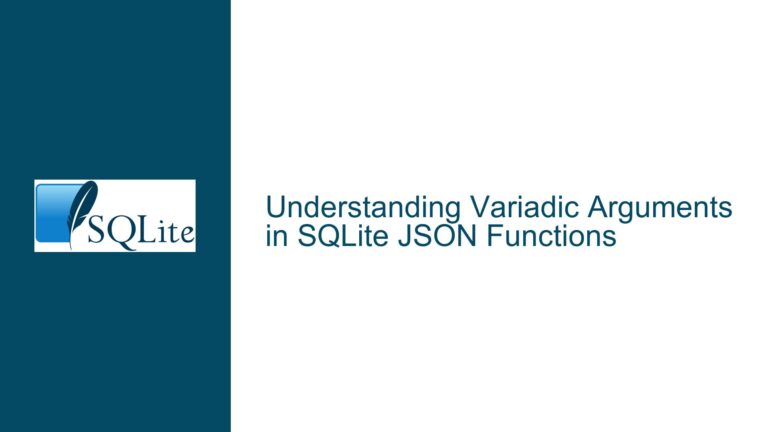Optimizing Dynamic Column Indexing in SQLite FTS5 Without Rebuilding Tables
Issue Overview: Dynamic Column Indexing in FTS5 Without Full Rebuild
The core challenge revolves around enabling on-demand indexing of additional columns in an SQLite FTS5 virtual table without requiring a full rebuild of the existing index. The user’s scenario involves a base table (products) with five columns (column1 to column5), where column3 is initially indexed using FTS5. The goal is to allow users to dynamically add or remove other columns (e.g., column1, column2) to the FTS5 index based on runtime requirements, such as UI-driven interactions. This avoids upfront indexing costs for columns that may never be queried, especially when dealing with large datasets. However, FTS5 is designed with a fixed schema, and its internal data structures (e.g., inverted indexes, shadow tables) are not natively mutable after creation. This creates a conflict between the need for flexibility and the limitations of SQLite’s FTS5 implementation.
The problem is further complicated by the use of external content tables or contentless tables, which rely on an external data source (the products table) to avoid duplicating content. While these configurations reduce storage overhead, they introduce synchronization challenges when modifying the FTS5 schema. For example, adding a new column to the FTS5 index requires updating the FTS5 table’s definition, regenerating its inverted index for the new column, and ensuring that existing documents (rows) in the products table are re-indexed. The absence of native ALTER TABLE support for FTS5 tables exacerbates this issue, forcing developers to consider unconventional workarounds or schema modifications.
Key technical constraints include:
- Fixed Schema Design: FTS5 tables are created with a predefined set of columns, and their internal shadow tables (e.g.,
fts5_table_data,fts5_table_docsize) are optimized for this structure. - Indexing Overhead: Rebuilding an FTS5 table from scratch to include new columns is computationally expensive, especially for large datasets.
- Synchronization Risks: Modifying FTS5’s internal tables directly (e.g.,
sqlite_master, shadow tables) can corrupt the database if not done atomically or consistently.
Possible Causes: Why Dynamic Column Indexing Fails in Standard FTS5
1. FTS5’s Inverted Index Structure
FTS5 builds an inverted index where terms are mapped to their locations across documents and columns. This index is optimized for the columns specified at creation time. Adding a new column requires updating this index to include terms from the new column, which FTS5 does not support incrementally. The inverted index is stored in a series of B-trees and hash tables within shadow tables (e.g., fts5_table_data), and their structure assumes a fixed column count.
2. Shadow Table Dependencies
FTS5 relies on internal shadow tables to manage document sizes, term frequencies, and positional data. For example:
fts5_table_docsizestores the size of each document (row) in terms of token counts per column.fts5_table_datastores compressed binary blobs representing the inverted index.
These tables are tightly coupled to the original FTS5 schema. Altering the column count invalidates their existing entries, as they lack metadata to accommodate new columns dynamically.
3. Contentless/External Content Limitations
While contentless or external content FTS5 tables avoid duplicating the base table’s data, they do not decouple the FTS5 schema from the base table. Adding a column to the FTS5 table still requires updating its schema and re-indexing all rows to include the new column’s data. The synchronization mechanism (e.g., triggers for INSERT, UPDATE, DELETE) does not account for schema changes, leading to inconsistencies if the FTS5 table’s column count diverges from the base table.
4. Column Filters vs. Indexing
The suggestion to use FTS5 column filters (e.g., MATCH 'col:value') addresses query-time column selection, not index-time column inclusion. Column filters allow searching within specific pre-indexed columns but do not enable dynamic addition of columns to the index itself. If a column is not indexed, queries against it will fall back to full-table scans, negating the benefits of FTS5.
5. Schema Modification Restrictions
SQLite’s ALTER TABLE command is limited to renaming tables or adding columns to regular tables. FTS5 virtual tables do not support ALTER TABLE, and their schemas are defined once at creation. Directly modifying sqlite_master to change an FTS5 table’s schema is unsupported and risks database corruption.
Troubleshooting Steps, Solutions & Fixes: Strategies for Dynamic Indexing
1. Standard Approach: Rebuilding the FTS5 Table
Steps:
- Drop the Existing FTS5 Table:
DROP TABLE IF EXISTS products_fts; - Recreate the FTS5 Table with New Columns:
CREATE VIRTUAL TABLE products_fts USING fts5( column3, column1, -- Added column1 content='products', content_rowid='id' ); - Rebuild the Index:
INSERT INTO products_fts (products_fts) VALUES ('rebuild');
Drawbacks:
- Requires re-indexing all rows, which is time-consuming for large datasets.
- Incurs downtime during the rebuild.
Mitigations:
- Use batch inserts and
PRAGMA synchronous=OFFduring rebuilds to speed up the process. - Maintain a temporary FTS5 table in the background and swap it atomically using
ATTACH DATABASE.
2. Advanced Workaround: Direct Shadow Table Manipulation
This method involves modifying FTS5’s internal tables to simulate dynamic column addition. Use with extreme caution and only in non-production environments.
Steps:
Update
sqlite_masterto Modify FTS5 Schema:UPDATE sqlite_master SET sql = replace(sql, 'column3)', 'column3, column1)') WHERE name = 'products_fts';This changes the FTS5 table’s schema definition but does not update its internal data structures.
Modify Shadow Tables:
fts5_table_data:
Add a zero-byte blob to theblockcolumn forid=1to signal a new column:UPDATE products_fts_data SET block = zeroblob(1) || block WHERE id = 1;fts5_table_docsize:
Extend theszcolumn for all rows to include a zero for the new column’s term count:UPDATE products_fts_docsize SET sz = sz || zeroblob(1);
Reset the Schema Cache:
PRAGMA writable_schema = RESET;Reindex New Column:
INSERT INTO products_fts (rowid, column1) SELECT id, column1 FROM products;
Risks:
- Directly modifying shadow tables bypasses SQLite’s integrity checks, risking index corruption.
- Undocumented behavior may change in future SQLite versions.
Verification:
- Query the FTS5 table to ensure the new column is searchable:
SELECT * FROM products_fts WHERE column1 MATCH 'search_term';
3. Alternative Design: Multiple FTS5 Tables with Union Queries
Instead of a single FTS5 table, use separate FTS5 tables for each column and combine results at query time.
Steps:
Create Per-Column FTS5 Tables:
CREATE VIRTUAL TABLE products_fts_col3 USING fts5(column3, content='products'); CREATE VIRTUAL TABLE products_fts_col1 USING fts5(column1, content='products');Query with
UNIONorUNION ALL:SELECT * FROM products_fts_col3 WHERE column3 MATCH 'term' UNION SELECT * FROM products_fts_col1 WHERE column1 MATCH 'term';
Performance Considerations:
- Storage Overhead: Each FTS5 table duplicates the tokenization structures for its column.
- Query Complexity: Unions may slow down queries due to multiple index scans.
Optimizations:
- Use
rowidalignment to avoid duplicate lookups:SELECT p.* FROM products p JOIN ( SELECT rowid FROM products_fts_col3 WHERE column3 MATCH 'term' UNION SELECT rowid FROM products_fts_col1 WHERE column1 MATCH 'term' ) AS fts ON p.id = fts.rowid;
4. Hybrid Approach: Partial Indexes with Materialized Views
Combine FTS5 with triggers and materialized views to simulate dynamic indexing.
Steps:
Create a Materialized View for Active Columns:
CREATE TABLE products_active_columns ( id INTEGER PRIMARY KEY, column3 TEXT, column1 TEXT -- Dynamically added/removed );Sync with Triggers:
CREATE TRIGGER products_after_insert AFTER INSERT ON products BEGIN INSERT INTO products_active_columns (id, column3, column1) VALUES (NEW.id, NEW.column3, NEW.column1); END;Create FTS5 on the Materialized View:
CREATE VIRTUAL TABLE products_fts USING fts5(column3, column1, content='products_active_columns');Dynamic Column Management:
- To add a column:
ALTER TABLE products_active_columns ADD COLUMN column2 TEXT; UPDATE products_active_columns SET column2 = (SELECT column2 FROM products WHERE id = products_active_columns.id); - Rebuild FTS5 after schema changes.
- To add a column:
Limitations:
- Materialized views require manual synchronization.
- Still involves FTS5 rebuilds when columns are added.
5. Custom Tokenization with Dynamic Columns
Leverage a custom tokenizer to include/exclude columns at query time without modifying the FTS5 schema.
Steps:
Create a Tokenizer that Consults a Runtime Configuration:
// Pseudocode for a tokenizer that reads active columns from a config table typedef struct CustomTokenizer { sqlite3_tokenizer base; int active_columns[5]; // 1 for active, 0 for inactive } CustomTokenizer; void read_active_columns(CustomTokenizer *t) { sqlite3_stmt *stmt; sqlite3_prepare_v2(db, "SELECT column FROM fts_config WHERE active=1", -1, &stmt, NULL); while (sqlite3_step(stmt) == SQLITE_ROW) { int col = sqlite3_column_int(stmt, 0); t->active_columns[col] = 1; } sqlite3_finalize(stmt); }Tokenize Only Active Columns:
In the tokenizer’sxTokenizemethod, skip columns marked as inactive.Query Using the Tokenizer:
SELECT * FROM products_fts WHERE products_fts MATCH 'term' AND column_filter = 'active';
Challenges:
- Requires writing a custom tokenizer in C.
- Configuration must be reloaded dynamically (e.g., via
PRAGMAcommands).
Final Recommendations:
- Default to Rebuilding: Despite its inefficiency, rebuilding FTS5 tables is the safest method.
- Avoid Shadow Table Hacks: These are brittle and best reserved for experimental use cases.
- Consider Alternative Databases: If dynamic schema changes are critical, evaluate databases like Elasticsearch or PostgreSQL with pg_trgm, which support partial or mutable indexes.
- Precompute Column Combinations: If the set of queryable columns is finite, create FTS5 tables for common combinations upfront.
By carefully weighing the trade-offs between flexibility, performance, and stability, developers can implement a solution that aligns with their application’s requirements.
